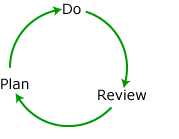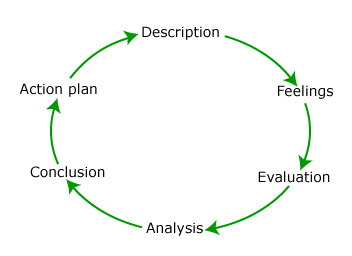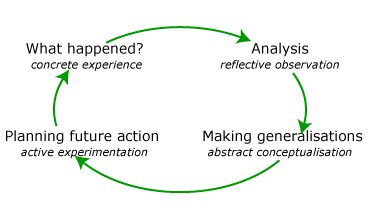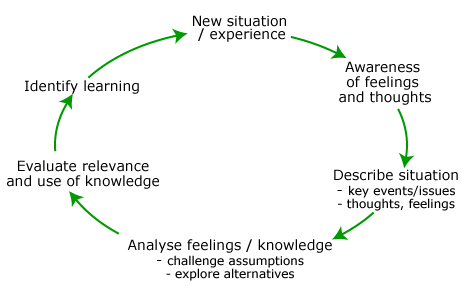Reflection
This article or section is currently under construction
In principle, someone is working on it and there should be a better version in a not so distant future.
If you want to modify this page, please discuss it with the person working on it (see the "history")
Definition
Reflection is a metacognitive strategy to help learners as individuals or organizations reflect upon experiences, actions and decisions taken. A practitioner engages in reflection when problem in practice arises and an attempt is made to understand and resolve it. Reflection as a pedagogy can be seen as an application of Dewey's experiential learning theories and extension to problem-based learning based on constructivist values. Reflection involves an active exploration of experiences to gain new or greater understanding.
Models of reflection
Many models of reflection have been proposed to be used as metacognitive tools.
Schön's model of reflective practice
Donald Schön looked at differentiating the tacit knowledge inherent in expert practitioners from explicit technical or theoretical knowledge, defining the notions of reflection-in-action (the use of a repertoire of theories, examples and actions to new situations, i.e. the capacity to think what one is doing while doing it) reflection-on-action (looking at the event or problem and how it was dealt with afterwards) (Schön, 1983).
The practice of using reflection as a learning strategy appears to focus on turning the latter into the former, so that learners may better capitalize on the learning opportunities offered in a particular experience and internalize the knowledge gained through their experience in order to build up a repertoire to draw upon in the future.
Other models
- Greenaway 3-stage model
Based on a simple 3-stage experiential learning cycle the Greenaway model suggests a Plan>>Do>>Review>> cycle

- Gibbs’ reflective cycle (1988)
- Johns’ model for structured reflection (1994)
More of a list of key questions to guide an analysis of a incident or general experience. Johns recognizes the benefits of sharing reflections which is an essential part of building a community of practice and the importance of the 'situatedness' of an incident as highlighted by the attention given to influencing factors and learning as involving considering actions to support others.
Johns' Model Of Reflection (1994)
- Description
Drawing out of the key issues within an experience through a description of thoughts and feelings and contextual background of the experience
- Reflection
Examination of one's motivations and the resulting actions, the consequences of actions for all stakeholders (including their possible emotional reactions).
- Influencing factors
Determining internal and external factors that influenced decisions and actions.Determine knowledge that did or should have influenced decisions and actions.
- Alternative strategies
Evaluation of one's actions and consideration of other possible choices and their respective consequences.
- Learning
Situating the experience and feelings within past experience and future practice and in providing support to others and considering the impact the experience will have on reflection-in-action.
- Structured reflection based on Kolb’s Learning Cycle (1984)
A model based directly on Kolb's experiential learning cycle where active experimentation leads to a transfer of learning from current cycle to a new cycle.
based on model described at [1]
- Rolfe et al (2001) Framework for reflexive practice
What? >> So what? >> Now what?
- Atkins and Murphy’s stage model of reflection (1994)
adapted from Atkins S, Murphy K (1994) found at [2]
Use of reflection in education
- professional development
- with adolescents
Promoting reflection-on-action
Any and any combination of these have been suggested as ways to enhance reflection-on-action (Sherwood, 2005; )
- Reflective writing in journals or blogs
- Video and Audio taping
- Critical incident technique - identifying particular helpful or unhelpful behaviours in a specific critical situation
- Discussion
- Drawing/ Concept mapping
- Role playing
- Storytelling
Promoting reflection-in-action
According to KBenetos, here the methods become a little more esoteric, but the aim of these activities are to provide physical relaxation and mental awareness and grounding that will enhance reflection in a particular situation.
- Mindfulness
- Meditation/Yoga/Physical activity
- Music
Reflective writing guidelines
The role of technologies in reflection
Related links
- Using a model of reflection
- Experiential Learning Cycle.
- Reflection
- The Reflective Practitioner - some definitions of reflective practice
References
- Atkins S, Murphy K (1994) Reflective Practice. Nursing Standard 8(39)49-56.
- Facilitating reflective practice.Peer Review of Learning and Teaching page at Cardiff University. Cardiff University 2007
- Greenaway, R. (1988). Powerful Learning Experiences in Management Learning and Development [3]
- Schön D (1983) The reflective practitioner. Basic Books: New York
- Sherwood, G. et al. (2005). The Scholarship of Reflective Practice, a resource paper from the Scholarship of Reflective Practice Task Force at University of North Carolina at Chapel Hill School of Nursing. [4]


